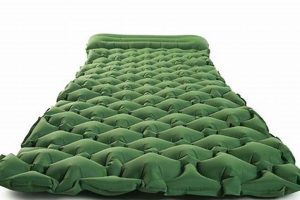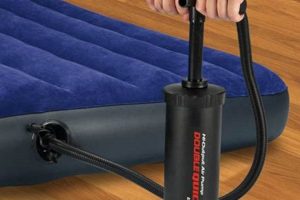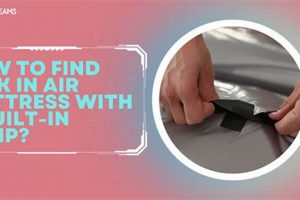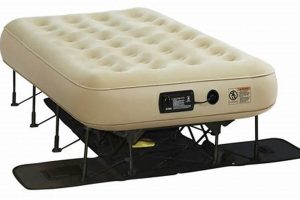An inflatable sleeping platform designed for use within the confines of an automobile, often tailored to fit the rear seating area or cargo space when the seats are folded down. These mattresses provide a relatively flat and cushioned surface for rest or sleep during travel or camping. A typical usage scenario involves inflating the structure using a portable pump, creating a makeshift bed inside the vehicle.
The primary advantage of such a device lies in its portability and convenience. It transforms a vehicle into a temporary sleeping space, eliminating the need for tents or lodging in certain situations. This can be particularly beneficial for long road trips, outdoor events, or emergency situations where a comfortable resting place is needed. Historically, improvisational sleeping arrangements in vehicles were common, but dedicated inflatable mattresses offer a more comfortable and hygienic alternative.
The subsequent sections will detail the various types available, factors to consider when selecting one, proper inflation and deflation techniques, maintenance procedures for longevity, and safety considerations for use inside a vehicle. Additional topics include compatible accessories, alternative uses, and a comparison to other portable bedding solutions.
Optimizing the Air Car Mattress Experience
The following guidelines are intended to maximize the utility and lifespan of an inflatable automobile sleeping platform, ensuring a comfortable and safe experience.
Tip 1: Selection Based on Vehicle Specifications: Prior to purchase, measure the available space within the target vehicle. Consider the dimensions of the rear seating area or cargo space with seats folded down to ensure proper fit and minimize gaps.
Tip 2: Thorough Inspection for Damage: Before each use, carefully examine the surface for punctures, tears, or weak points. Particular attention should be paid to seams and valve areas, as these are common failure points.
Tip 3: Controlled Inflation Practices: Avoid over-inflation, as this can lead to seam rupture and structural failure. Utilize a pump with a pressure gauge to ensure inflation remains within the manufacturer’s recommended range. In colder temperatures, inflate slightly less, as air expands with warmth.
Tip 4: Implementation of Protective Barriers: To prevent damage from sharp objects or abrasive surfaces within the vehicle, place a protective layer between the vehicle’s interior and the device. This may include blankets, fitted sheets, or dedicated protective mats.
Tip 5: Strategic Weight Distribution: Distribute weight evenly across the surface. Avoid concentrating excessive weight in a single area, particularly near the edges or seams. This reduces stress and minimizes the risk of deformation or failure.
Tip 6: Regular Cleaning Protocols: After each use, clean the surface with a damp cloth and mild detergent. Allow the surface to dry completely before storage to prevent the growth of mold or mildew.
Tip 7: Appropriate Storage Techniques: When not in use, deflate completely and store in a cool, dry place, away from direct sunlight and extreme temperatures. Utilize the provided storage bag to protect it from physical damage during transport and storage.
By adhering to these recommendations, users can extend the longevity of their inflatable automobile sleeping platforms and maintain a comfortable and safe sleeping environment while traveling.
The next section will delve into common issues and troubleshooting steps to maintain optimal performance.
1. Vehicle Compatibility
Vehicle compatibility is a critical determinant of an inflatable automobile sleeping platform’s functionality and user satisfaction. Incompatibility leads to compromised safety, reduced comfort, and potential damage to the vehicle’s interior. A structure too large will not fit, rendering it unusable. Conversely, an undersized structure will fail to provide adequate support and may shift during use, increasing the risk of discomfort or injury. For instance, installing a full-size mattress intended for a large SUV in a compact car will likely result in significant folding and buckling, negating its intended purpose and potentially obstructing access to vehicle controls.
The physical dimensions of the vehicle’s rear seating area or cargo space, with seats folded down, must be accurately measured and compared against the dimensions of the chosen inflatable structure. Features like wheel well protrusions, console placement, and seat contours can significantly impact available space. Some manufacturers offer vehicle-specific models tailored to common vehicle makes and models, ensuring a more precise fit. Others provide universal designs intended to accommodate a wider range of vehicles. Proper inflation and deflation can become problematic if its is over pressured that make air car mattress could exploded.
Achieving optimal vehicle compatibility requires careful pre-purchase assessment and, ideally, a physical test fit. Failure to account for vehicle-specific dimensions can result in an unsatisfactory and potentially hazardous user experience, undermining the intended benefits of transforming a vehicle into a comfortable resting space. Thus, accurate measurements and informed product selection are essential prerequisites for safe and effective use.
2. Material Durability
Material durability is a primary determinant of the lifespan and functional effectiveness of an inflatable automobile sleeping platform. The ability of the materials used in construction to withstand the stresses of repeated inflation, deflation, weight bearing, and environmental exposure directly impacts the overall value and utility of the product.
- Puncture Resistance
The outer layer of the mattress is frequently exposed to sharp objects within the vehicle’s interior, such as seatbelt buckles, zippers, and debris. Materials with high puncture resistance, such as reinforced PVC or multi-layered composites, are essential to prevent air leaks and maintain structural integrity. For example, a mattress constructed from thin, unreinforced vinyl is significantly more susceptible to punctures than one utilizing a thicker, coated fabric.
- Abrasion Resistance
Repeated contact with the vehicle’s upholstery and interior surfaces can cause abrasion and wear. Materials that exhibit high abrasion resistance, such as flocked surfaces or textured coatings, minimize friction and prevent degradation of the outer layer. Constant rubbing against rough surfaces can compromise the material, leading to thinning and eventual failure.
- Tensile Strength
The internal seams and structural components of the mattress must withstand significant tensile forces generated during inflation and weight bearing. High-tensile-strength materials, such as reinf
orced nylon or polyester, are crucial for preventing seam separation and structural deformation. Insufficient tensile strength can lead to bulging, sagging, or complete rupture of the mattress under load. - Environmental Degradation Resistance
Exposure to ultraviolet (UV) radiation, temperature fluctuations, and humidity can degrade the material over time, causing it to become brittle, discolored, or prone to cracking. UV-resistant coatings and materials with inherent resistance to environmental degradation, such as certain types of polymers, extend the lifespan of the mattress and maintain its aesthetic appeal. Prolonged exposure to direct sunlight can significantly reduce the material’s flexibility and strength.
The selection of materials with appropriate puncture, abrasion, tensile, and environmental degradation resistance properties is essential for ensuring the longevity, reliability, and overall user satisfaction of inflatable automobile sleeping platforms. Prioritizing material durability during the purchasing process represents a long-term investment in product performance and safety.
3. Inflation Method
The inflation method constitutes a critical functional aspect of an inflatable automobile sleeping platform. The chosen inflation technique and associated apparatus directly influence the speed, ease, and convenience of deploying the mattress within the confined space of a vehicle. A poorly designed or implemented inflation method can negate the advantages of portability and comfort that these mattresses are intended to provide. For instance, a mattress requiring a manual foot pump for inflation may prove cumbersome and physically demanding to inflate fully within the limited space of a car, especially in adverse weather conditions. This would then negate the advantage of this sleeping solution.
Common inflation methods include manual pumps (foot or hand-operated), electric pumps (powered by the vehicle’s 12V outlet or batteries), and self-inflating mechanisms. Electric pumps offer the advantage of speed and reduced physical exertion, particularly beneficial for larger mattresses or individuals with limited mobility. Self-inflating mattresses utilize open-cell foam that expands and draws in air when a valve is opened, requiring only minimal supplemental inflation. Each method presents trade-offs in terms of cost, portability, and inflation time. A built-in electric pump can simplify setup but may increase the overall weight and cost of the mattress.
Selecting an appropriate inflation method requires careful consideration of the user’s physical capabilities, vehicle power availability, and the desired level of convenience. A reliable and efficient inflation method is essential for maximizing the usability and practicality of an inflatable automobile sleeping platform, ensuring a comfortable and hassle-free experience when converting a vehicle into a temporary sleeping space. The integration of pressure sensors and automatic shut-off mechanisms further enhances the user experience by preventing over-inflation and potential damage to the mattress.
4. Storage Efficiency
Storage efficiency is a crucial design consideration for inflatable automobile sleeping platforms. The inherently portable nature of these devices necessitates compact storage capabilities to minimize space consumption within the vehicle when not in use. Achieving optimal storage efficiency directly contributes to the practicality and convenience of this automotive accessory.
- Deflated Volume Minimization
The primary goal of storage efficiency is to minimize the volume occupied by the device when deflated. This is achieved through material selection (thin, foldable fabrics), efficient deflation valve designs, and strategic folding techniques. A device that packs down to a small, manageable size can be easily stowed in the trunk, under a seat, or within other storage compartments of the vehicle.
- Integrated Storage Solutions
Some designs incorporate integrated storage solutions, such as attached storage bags or compression straps, to further enhance storage efficiency. These features streamline the packing process and prevent the device from unfolding or expanding during transport. Integrated storage bags also offer protection from dirt and damage.
- Weight Considerations
While volume is a primary concern, weight also contributes to storage efficiency. A lightweight design reduces the overall burden on the vehicle’s cargo capacity and facilitates easier handling during packing and unpacking. Material selection and construction techniques play a significant role in minimizing weight without compromising durability.
- Shape Optimization for Storage
The shape of the deflated mattress can be optimized for efficient storage in specific areas of the vehicle. Rectangular or square shapes are often easier to stack and organize than irregular shapes. Manufacturers may consider the dimensions of common storage compartments when designing the deflated shape of the device.
The interplay of deflated volume, integrated storage solutions, weight considerations, and shape optimization collectively determines the storage efficiency of an inflatable automobile sleeping platform. These factors are essential for ensuring that the device remains a practical and convenient solution for mobile rest and recreation, rather than becoming a bulky and cumbersome burden. Prioritizing storage efficiency enhances the overall user experience and reinforces the value proposition of these portable sleeping solutions.
5. Comfort Level
Comfort level is a primary attribute influencing the utility and acceptance of an inflatable automobile sleeping platform. The inherent purpose of such a device is to provide a suitable resting environment within a vehicle, making comfort a non-negotiable factor. An uncomfortable mattress negates the benefit of convenient sleeping arrangements and diminishes the overall value proposition. Real-world examples consistently demonstrate that individuals are less likely to utilize these sleeping arrangements if they are perceived as significantly less comfortable than alternative options such as traditional mattresses or even basic camping pads.
Several factors directly contribute to the comfort level afforded by these devices. These include the material composition of the sleeping surface, the internal support structure, the overall thickness of the inflated mattress, and the presence of supplementary features such as integrated pillows or textured surfaces. A thicker mattress generally provides better cushioning and support, reducing pressure points and improving spinal alignment. The surface material impacts breathability and temperature regulation, influencing the sleep environment’s overall comfort. Furthermore, the degree to which the mattress conforms to the body’s contours determines the distribution of weight and the reduction of localized pressure.
Understanding the correlation between design features and comfort level is critical for manufacturers seeking to optimize their products. While portability and ease of use are important consideration
s, they must not come at the expense of comfort. The challenge lies in striking a balance between these factors, creating a sleeping platform that is both compact and sufficiently comfortable to promote restful sleep. Ultimately, the success of an inflatable automobile sleeping platform hinges on its ability to provide a genuinely comfortable alternative to more conventional sleeping arrangements.
6. Safety Features
Safety features integrated into inflatable automobile sleeping platforms are paramount, mitigating potential hazards associated with their use within the confined space of a vehicle. The absence of appropriate safety considerations can lead to increased risk of injury during transit or while stationary.
- Non-Slip Surface Treatments
Application of non-slip materials or textured surfaces to the exterior of the mattress is crucial in preventing unwanted movement during use. Slippage can lead to occupant displacement, potentially causing injury or hindering access to vehicle controls in emergency situations. For example, a smooth PVC surface on an inclined seat could result in the occupant sliding downwards during sleep, compromising posture and safety.
- Secure Inflation Valve Design
The inflation valve must be designed to prevent accidental deflation. A valve that is easily dislodged or prone to leakage can result in a sudden loss of air pressure, causing discomfort or instability. Implementation of a recessed valve design or a robust locking mechanism is essential for maintaining consistent support.
- Flame-Retardant Materials
Utilization of flame-retardant materials in the construction of the mattress is a critical safety measure. In the event of a vehicle fire, these materials reduce the rate of combustion, providing occupants with additional time to evacuate the vehicle. Compliance with established flammability standards, such as those outlined by the National Highway Traffic Safety Administration, is imperative.
- Emergency Deflation Mechanism
The inclusion of a rapid deflation mechanism, such as a quick-release valve, facilitates swift removal of the mattress from the vehicle in emergency situations. This feature is particularly important in scenarios where rapid egress is necessary, such as following an accident or during a flood. The mechanism should be easily accessible and operable even in low-light conditions.
These integrated safety features collectively contribute to a safer environment within the vehicle when using inflatable automobile sleeping platforms. Prioritizing these elements during product design and selection is essential for minimizing potential risks and ensuring occupant well-being.
7. Maintenance Requirements
The longevity and hygienic state of an inflatable automobile sleeping platform are directly contingent upon adherence to recommended maintenance protocols. Neglecting these requirements can lead to premature material degradation, compromised structural integrity, and the potential for unsanitary conditions, ultimately reducing the lifespan and usability of the device.
- Regular Cleaning Protocols
Periodic cleaning of the mattress surface is essential to remove dirt, debris, and bodily fluids that accumulate during use. Failure to do so can foster the growth of mold, mildew, and bacteria, creating an unsanitary sleeping environment. Recommended cleaning practices involve wiping the surface with a damp cloth and mild detergent, followed by thorough drying. Harsh chemicals or abrasive cleaners should be avoided, as they can damage the mattress material.
- Proper Deflation and Storage Techniques
Correct deflation and storage are critical for preserving the integrity of the mattress material and preventing damage during periods of non-use. The mattress should be fully deflated before folding to minimize stress on the seams and internal structure. It should then be stored in a cool, dry environment, away from direct sunlight and extreme temperatures. Utilizing the manufacturer-provided storage bag further protects the mattress from physical damage and environmental exposure.
- Inspection and Repair of Minor Damage
Regular inspection of the mattress surface for punctures, tears, or seam separations is essential for early detection of potential problems. Minor damage, such as small pinholes, can often be repaired using readily available patch kits. Addressing these issues promptly prevents them from escalating into more significant structural failures. Neglecting minor damage can lead to gradual air leakage and eventual loss of functionality.
- Valve Maintenance and Seal Integrity
The inflation and deflation valves are critical components that require periodic maintenance to ensure proper sealing and functionality. Valves should be inspected for debris or damage that could compromise their ability to maintain airtight closure. Cleaning the valve mechanism and ensuring proper seating of the valve cap are essential for preventing air leaks and maintaining consistent mattress inflation.
These maintenance protocols are indispensable for prolonging the lifespan and ensuring the continued hygienic use of inflatable automobile sleeping platforms. Consistent adherence to these practices not only maximizes the investment in the product but also contributes to a more comfortable and sanitary resting environment within the vehicle.
Frequently Asked Questions
This section addresses common inquiries and concerns regarding inflatable automobile sleeping platforms, providing factual and objective information to aid in informed decision-making.
Question 1: What factors determine the suitability of an inflatable automobile sleeping platform for a specific vehicle?
Vehicle compatibility is primarily determined by the dimensions of the rear seating area or cargo space when the seats are folded down. Accurate measurements are essential to ensure proper fit and avoid compromising safety or comfort. Consult product specifications and, ideally, conduct a physical test fit prior to purchase.
Question 2: How does material durability affect the lifespan of an inflatable automobile sleeping platform?
Material durability dictates the mattress’s resistance to punctures, abrasion, and environmental degradation. Higher-quality materials, such as reinforced PVC or multi-layered composites, offer greater longevity and resistance to wear and tear, extending the usable lifespan of the device.
Question 3: What are the advantages and disadvantages of different inflation methods?
Manual pumps offer portability but require physical exertion. Electric pumps provide convenience but may require a power source. Self-inflating mechanisms offer ease of use but may not provide the same level of firmness. The optimal method depends on individual needs and preferences.
Question 4: How can the storage efficiency of an inflatable automobile sleeping platform be maximized?
Storage efficiency is maximized by minimizing the deflated volume, utilizing integrated storage solutions such as compression straps or storage bags, and optimizing the deflated shape for easy stowing within the
vehicle.
Question 5: What safety features should be considered when selecting an inflatable automobile sleeping platform?
Essential safety features include non-slip surface treatments to prevent unwanted movement, secure inflation valve designs to prevent accidental deflation, flame-retardant materials to mitigate fire hazards, and emergency deflation mechanisms to facilitate rapid egress.
Question 6: What maintenance practices are recommended to prolong the lifespan of an inflatable automobile sleeping platform?
Recommended maintenance practices include regular cleaning with mild detergent, proper deflation and storage in a cool, dry environment, inspection and repair of minor damage, and maintenance of the inflation and deflation valves to ensure airtight closure.
In summary, the optimal inflatable automobile sleeping platform is characterized by vehicle compatibility, material durability, appropriate inflation method, maximized storage efficiency, integral safety features, and diligence in maintenance requirements. A proper investment of time and resources will yield long term positive usage of such device.
The next section will explore alternative uses and applications of inflatable automobile sleeping platforms beyond their primary function.
Conclusion
This exploration has elucidated the multifaceted aspects of the air car mattress, encompassing its definition, benefits, selection criteria, maintenance, and safety considerations. The importance of vehicle compatibility, material durability, efficient inflation methods, space-saving storage, and integrated safety features has been emphasized. Furthermore, recommended maintenance protocols have been presented as crucial for preserving the device’s functionality and hygiene.
The air car mattress, when selected and maintained appropriately, represents a practical solution for mobile rest and recreation. Continued advancements in materials and design hold the potential to further enhance its comfort, safety, and utility. Responsible usage, adhering to established safety guidelines, is paramount for maximizing the benefits and minimizing potential risks associated with its application within the automotive environment.







![Best Air Mattress Alternative [Top Picks!] Organic & Natural Mattress Buyer’s Guide: Non-Toxic Sleep Solutions Best Air Mattress Alternative [Top Picks!] | Organic & Natural Mattress Buyer’s Guide: Non-Toxic Sleep Solutions](https://mattressworldpa.com/wp-content/uploads/2025/07/th-6618-300x200.jpg)